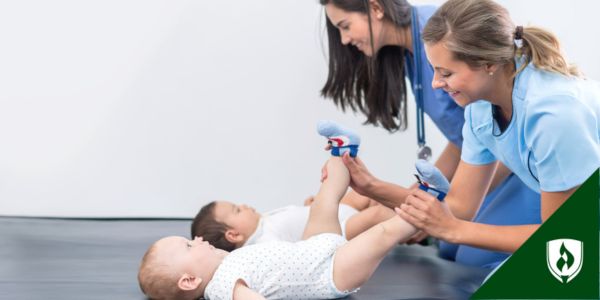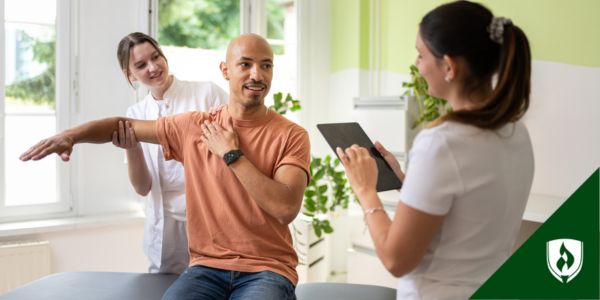
You’re ready for a career that not only provides for your family, but also impacts others and lets you stay active. If you’ve always had a knack for taking care of and encouraging others, you could be a perfect fit for a physical therapist assistant career.
Couple that with a manageable education path—typically an Associate’s degree program—and you're likely a little intrigued. Would you like the work? What do physical therapist assistants, or PTAs, actually do in their day-to-day?
PTAs team up with physical therapists to help patients regain their full range of motion after an injury or when an illness temporarily takes them out of the game. Their duties vary widely, including some surprising tasks you may not have expected. Learn more about the distinctions between Occupational Therapist vs. Physical Therapist, and read on to find out if these physical therapist assistant job duties sound like the makings of your new dream career.
What does a physical therapist assistant do?
As we mentioned, PTAs work closely with a team of physical therapists, physical therapy aides and other PTAs to rehabilitate patients who are working to regain their full range of motion and strengthen injured or atrophied muscle groups. They spend lots of time working one-on-one with patients, observing their progress and showing them new stretches and exercises that aim to speed their physical recovery.
Some essential physical therapist assistant duties, according to the BLS, include:1
1. Observing patients
PTAs spend much of their day carefully observing their patients’ progress. They record careful notes so they can give detailed reports to the physical therapist and determine the next best step in their patients’ recovery. Their observation work is also important for ensuring patients are sticking to the prescribed routine and using proper form—cutting corners doesn’t help a patient long term.
2. Assisting patients through exercises
Physical therapy can be a slow, difficult process—and the exercises prescribed to patients can often be challenging. As patients work through rehabilitation, they need strong arms and shoulders to sometimes literally lean on. PTAs have the chance to give encouragement, support and motivation to their patients as they help them complete their exercises.
3. Treating patients with therapeutic interventions
PTAs use a wide range of techniques to help their patients regain typical range of motion, including therapeutic massage. This special massage technique can help relieve pain, decrease muscle tension and increase blood flow, all of which are critical in the healing process.
Physical therapist assistants may also employ other techniques like stretching or therapeutic ultrasound, a process that releases sound waves to increase blood flow, loosen tissues and reduce swelling.
4. Teaching patients how to use equipment
While there’s a wide array of helpful rehabilitative equipment and tools at a PTA’s disposal, not all are very intuitive to use. Whether it means helping young patients learn how to use a pediatric gait trainer, teaching an injured patient how to maneuver a walker or explaining how to get the most out of those unassuming foam rollers, PTAs have the important task of making sure each patient feels confident and secure with any equipment they need.
Since PTAs may also work with amputees, they may be tasked with helping patients adjust to prosthetics. Prosthetics and equipment require careful rehabilitation and training plans to help patients gain as much function as possible.
5. Educating patients and their loved ones
A patient’s treatment doesn’t end when they leave the physical therapy facility. PTAs are often responsible for making sure a patient and their loved ones understand which exercises and stretches they need to do at home to continue their rehabilitation. Patients and their families need a PTA who can explain exactly how the treatment plan works and answer any lingering questions they may have. Well-informed patients and families can help with keeping everyone bought-in and committed to sticking to their rehabilitation routine.
What is working as a PTA like?
As you can see, PTAs spend most of their day communicating with others, whether it’s explaining a treatment plan to a patient or reporting back to the physical therapist with the day’s reports and observations. This is a very interactive role where you can expect to work with a steady stream of patients—all with different needs—every day.
It’s not just about communicating technical rehabilitation details—PTAs do their fair share of “cheerleading” as patients push themselves toward progress. This encouragement may come easily for many; after all, it’s a pretty incredible feeling to see someone regain their mobility. But physical therapy can also be frustrating and painful for patients. PTAs need compassion as well as patience to be as helpful as possible to everyone’s recovery.
As in many healthcare careers, physical therapist assistants can work in specialized environments, like a children’s hospital or a center devoted to athletic injuries. You could work in a hospital, a clinic, a nursing home and many other types of healthcare facilities.
Is a physical therapist assistant career on your radar?
A physical therapist assistant’s job duties may seem routine to the untrained eye. But thanks to this breakdown, you know there’s more to the story of what a PTA does all day. Can you see yourself stepping into this career and helping patients step into their healing and rehabilitation? Not sure what the difference is between a PT vs. PTA is? Read more in our article here.
If so, becoming a PTA might be your next career move. Find out if you’re a good fit with these “7 Signs You Should Consider Becoming a Physical Therapist Assistant.”
Related Articles:
1Bureau of Labor Statistics, U.S. Department of Labor, Occupational Outlook Handbook, [career information accessed September, 2021] www.bls.gov/ooh/. Information represents national, averaged data for the occupations listed and includes workers at all levels of education and experience. Employment conditions in your area may vary.




